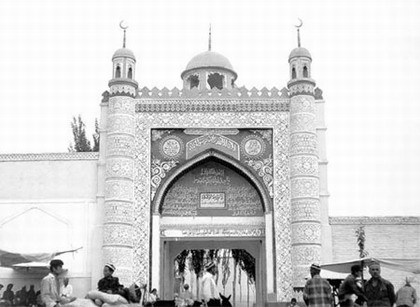
|
CHINA> Background
 |
|
History of the Uygurs
(China Daily)
Updated: 2009-07-13 08:33 Uygur means union or alliance. Modern Uygur people can trace their ancestors back to the nomadic tribes who lived in the area of Lake Baikal and the Irtish River further north of today's Mongolia about 200 BC, contemporaneously with the Han Dynasty of the Middle Kingdom. Among the numerous names these tribes took up was Uighur or Ouigour.
 In AD 744, the Uighur founded a khanate in Mobei, an area encompassing Lake Baikal and Mongolia. They even dispatched troops twice to help the Tang central authorities to quell rebellions. However, the Uighur Khanate collapsed in 840 because of natural disasters, internal strife and attacks by neighboring tribes. Consequently, most of the Uighur migrated westward. One of their sub-groups moved to the modern Jimsar and Turpan in Xinjiang, where they founded the Gaochang Uighur Kingdom. Another sub-group moved to the Central Asian grasslands, scattered in areas from Central Asia to Kashi, and joined other peoples in founding the Karahan Kingdom. After that, the Tarim Basin and its surrounding areas were under the rule of the Gaochang Uighur Kingdom and the Karahan Kingdom. The local residents were merged with the Uighurs that had moved west, thus laying the foundation for the subsequent formation of the Uygur ethnic group. In the middle of the 10th century, the Uighurs founded the Hala Khanate, which had a profound influence on the development of Uighur history. During that period, Uighur farming communities began to appear and the Uygurs made rapid socio-economic and cultural progress. Prosperous trading took place in which horses, jade articles and herbs were transported inland in exchange for silk, tea and money.
In 1371, the Mongol Empire of the Chagatai Khanate collapsed and many separatist regimes were set up by descendants of the Mongols. Continuous wars greatly damaged the Uighur society and economy. The Yarkant Kingdom was founded in the early 17th century in an area south of the Tianshan Mountain. Most of the residents of the Kingdom were Islamic Uighurs. They maintained a peaceful trading relationship with the Qing Dynasty. Tribal wars broke out in 1678 and the Baishan tribe together with the Mongol Dzungar force invaded the south, which eventually led to the demise of the Yarkant Kingdom. From 1755 to 1759, the Qing government successfully suppressed the Dzungar and Khoja revolts. The government eventually established the military administration known as the Ili General in Huiyuan city to rule the Xinjiang region and the areas south and east of Balkhash Lake. China Daily |
主站蜘蛛池模板: 精品国产精品 | 性欧美成人依依影院 | 国产综合在线视频 | 欧美一级久久久久久久久大 | 5x社区直接进入一区二区三区 | 波多野结衣在线观看免费区 | 一区二区三区久久 | 欧美成人三级大全 | 日本一在线中文字幕天堂 | 国产亚洲欧美日韩在线观看一区二区 | 欧美日韩专区国产精品 | 久草欧美| 中文字幕一区二区视频 | 蜜桃欧美性大片 | 在线aaa| 日本高清在线中文字幕网 | 色www永久免费网站国产 | 正在播放亚洲一区 | 一区二区3区免费视频 | 美女黄页网站免费进入 | 成人亚洲视频在线观看 | 亚洲综合伦理一区 | 一级做a毛片在线看 | 国产成 人 综合 亚洲绿色 | 一级做a爰片久久毛片16 | 国产精品免费一级在线观看 | 成人在线免费视频播放 | 午夜mm131美女做爰视频 | 特黄毛片| 另类亚洲孕妇分娩网址 | 国产做a爰片久久毛片 | 精品国产看高清国产毛片 | 免费观看一级成人毛片软件 | 日本一区二区三区四区不卡 | 狠狠干香蕉 | 成人精品视频在线 | 成人性欧美丨区二区三区 | 国产一及片 | 99在线观看视频免费精品9 | 八戒午夜精品视频在线观看 | 在线观看亚洲精品专区 |